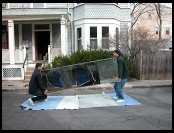
Nikon Coolpix 5000
by Philip Greenspun; created March, 2002
Site Home : Photography : Nikon Coolpix 5000

by Philip Greenspun; created March, 2002
Site Home : Photography : Nikon Coolpix 5000
If you like the Nikon Coolpix 99x series of cameras you'll love the $1000 digital point-and-shoot Coolpix 5000. Operating speed and buffering of recently exposed images is greatly improved over earlier Nikon digital cameras. The compact body is traditional in style, with a camcorder-style fold-out LCD display rather than the 99x-series split/twist body. Image quality is excellent and resolution is 5 megapixels (2560x1920 pixels). The slow lens (f/2.8-4.8) is equivalent to a 28-85mm zoom on a 35mm camera. Bit depth for both JPEG and TIFF images is 8 bits per color.
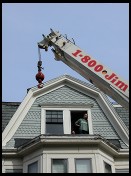
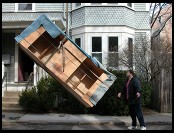
The Coolpix 5000 might have been a nice pocket camera but for its slow statup time and lack of a motorized lens cover. Nikon provides a standard plastic lens cap. Suppose that you turn the camera on and forget to remove the lens cap. The viewfinder looks normal so you press the shutter release. Nothing happens. Pull your eye away from the viewfinder to the top-rear LCD display: it is flashing "err" in the bottom right corner. Remove the lens cap. Press the shutter release again. Nothing happens. You have to turn the camera off and then on again before you can take photographs.
As a scientific instrument for producing 8-bit JPEGs, the Coolpix 5000 is nearly perfect. Macro capability is similar to what you get on a 35mm camera with a 1:1 lens, i.e., you can take a full-frame picture of something 1.5" (36mm) across. But for general-purpose photography I find the camera, like nearly all point-and-shoot digitals, a frustrating toy. It takes too long to start up. The viewfinder is too small and inaccurate. The user interface is too confusing and complex. The buttons are too small and too numerous. The 8-bit exposure scale isn't enough for contrasty lighting.
The photos on this page were quick auto-everything snapshots taken when a 300-gallon aquarium (for African Cichlids) was being craned into my living room.
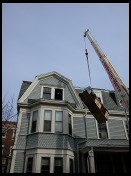
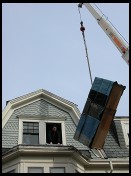
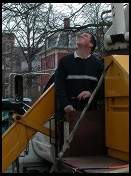
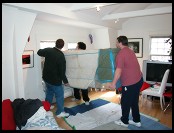 External Nikon flashes can be used with
the Coolpix 5000. This is an important feature considering
External Nikon flashes can be used with
the Coolpix 5000. This is an important feature considering
One amusing note for the annals of product design is that Nikon placed the flash exposure sensor just behind where your fingers would naturally fall on the handgrip. If your fingers cover the sensor, the flash blasts out its maximum power, potentially washing out your subject. Nikon apparently did not discover this phenomenon until after the manual was prepared, for the camera comes packaged with a hastily Xeroxed warning page.
Right: on-camera flash; everything auto.
You can throw out the CD-ROM that Nikon includes with the Nikon 5000. It includes a crippled demo version of an image library management tool. It includes a non-Adobe image editor of some sort. You're far better off using the image management features built into Windows XP. You'll be making heavy use of Microsoft's "Rotate Counterclockwise" option. Nikon did not give the Coolpix 5000 a sensor capable of determining whether the camera was being held vertically or horizontally. Consequently, the camera generates incorrectedly oriented JPEGs whenever it is held vertically.
If you're willing tolerate more cost, weight, and bulk, a zoom-lens reflex (ZLR) like the Olympus E-10 or E-20 pays huge dividends in terms of viewfinder quality.
Text and photos copyright 2002 Philip Greenspun.